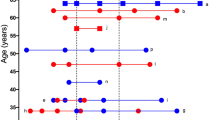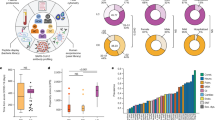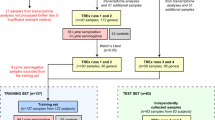Abstract
The human T-cell leukemia virus type I (HTLV-I) is the causative agent for adult T-cell leukemia (ATL) and HTLV-I-associated myelopathy/tropical spastic paraparesis (HAM/TSP). Approximately 5% of infected individuals will develop either disease and currently there are no diagnostic tools for early detection or accurate assessment of disease state. We have employed high-throughput expression profiling of serum proteins using mass spectrometry to identify protein expression patterns that can discern between disease states of HTLV-I-infected individuals. Our study group consisted of 42 ATL, 50 HAM/TSP, and 38 normal controls. Spectral peaks corresponding to peptide ions were generated from MS-TOF data. We applied Classification and Regression Tree analysis to build a decision algorithm, which achieved 77% correct classification rate across the three groups. A second cohort of 10 ATL, 10 HAM and 10 control samples was used to validate this result. Linear discriminate analysis was performed to verify and visualize class separation. Affinity and sizing chromatography coupled with tandem mass spectrometry was used to identify three peaks specifically overexpressed in ATL: an 11.7 kDa fragment of alpha trypsin inhibitor, and two contiguous fragments (19.9 and 11.9 kDa) of haproglobin-2. To the best of our knowledge, this is the first application of protein profiling to distinguish between two disease states resulting from a single infectious agent.
This is a preview of subscription content, access via your institution
Access options
Subscribe to this journal
Receive 12 print issues and online access
$259.00 per year
only $21.58 per issue
Buy this article
- Purchase on Springer Link
- Instant access to full article PDF
Prices may be subject to local taxes which are calculated during checkout







Similar content being viewed by others
References
Hobbs SK, Shi G, Homer R, Harsh G, Atlas SW, Bednarski MD . Magnetic resonance image-guided proteomics of human glioblastoma multiforme. J Magn Reson Imaging 2003; 18: 530–536.
Bangham CR . HTLV-1 infections. J Clin Pathol 2000; 53: 581–586.
de The G, Bomford R . An HTLV-I vaccine: why, how, for whom? AIDS Res Hum Retroviruses 1993; 9: 381–386.
Tajima K . The fourth nation-wide study of adult T-cell leukemia/lymphoma (ATL) in Japan: estimates of risk of ATL and its geographic and clinical features. Int J Cancer 1990; 45: 237–243.
Pawson R, Richardson DS, Pagliuca A, Kelsey SM, Hoque S, Breuer J et al. Adult T-cell leukemia/lymphoma in London: clinical experience of 21 cases. Leuk Lymphoma 1998; 16: 32–50.
Matutes E, Chan LC . Mixed-lineage leukemia revisited: acute lymphocytic leukemia with myeloperoxidase-positive blasts by electron microscopy. Blood 1991; 77: 410–411.
Group LS . Major prognostic factors of patients with adult T-cell leukemia–lymphoma: a cooperative study. Leuk Res 1991; 15: 81–90.
Mora CA, Osame M, Jacobson S . Human T lymphotrophic virus type-I associated myelopathy/tropical spastic paraparesis (HAM/TSP): therapeutic approach. Curr Treat Options Infect Dis 2003; 5: 443–455.
Li J, Zhang Z, Rosenzweig J, Wang YY, Chan DW . Proteomics and bioinformatics approaches for identification of serum biomarkers to detect breast cancer. Clin Chem 2002; 48: 1296–1304.
Adam BL, Qu Y, Davis JW, Ward MD, Clements MA, Cazares LH et al. Serum protein fingerprinting coupled with a pattern-matching algorithm distinguishes prostate cancer from benign prostate hyperplasia and healthy men. Cancer Res 2002; 62: 3609–3614.
Wadsworth JT, Somers KD, Cazares LH, Malik G, Adam BL, Stack Jr BC et al. Serum protein profiles to identify head and neck cancer. Clin Cancer Res 2004; 10: 1625–1632.
Vlahou A, Schellhammer PF, Mendrinos S, Patel K, Kondylis FI, Gong L et al. Development of a novel proteomic approach for the detection of transitional cell carcinoma of the bladder in urine. Am J Pathol 2001; 158: 1491–1501.
Petricoin EF, Ardekani AM, Hitt BA, Levine PJ, Fusaro VA, Steinberg SM et al. Use of proteomic patterns in serum to identify ovarian cancer. Lancet 2002; 359: 572–577.
Qu Y, Adam BL, Yasui Y, Ward MD, Cazares LH, Schellhammer PF et al. Boosted decision tree analysis of surface-enhanced laser desorption/ionization mass spectral serum profiles discriminates prostate cancer from noncancer patients. Clin Chem 2002; 48: 1835–1843.
Bertone P, Kluger Y, Lan N, Zheng D, Christendat D, Yee A et al. SPINE: an integrated tracking database and data mining approach for identifying feasible targets in high-throughput structural proteomics. Nucleic Acids Res 2001; 29: 2884–2898.
Kosuda S, Ichihara K, Watanabe M, Kobayashi H, Kusano S . Decision-tree sensitivity analysis for cost-effectiveness of whole-body FDG PET in the management of patients with non-small-cell lung carcinoma in Japan. Ann Nucl Med 2002; 16: 263–271.
Semmes OJ, Feng Z, Adam BL, Banez LL, Bigbee WL, Campos D et al. Evaluation of serum protein profiling by surface-enhanced laser desorption/ionization time-of-flight mass spectrometry for the detection of prostate cancer: I. Assessment of platform reproducibility. Clin Chem 2005; 51: 102–112.
Sun Z, Yang P . Role of imbalance between neutrophil elastase and alpha 1-antitrypsin in cancer development and progression. Lancet Oncol 2004; 5: 182–190.
Arredouani M, Matthijs P, Van Hoeyveld E, Kasran A, Baumann H, Ceuppens JL et al. Haptoglobin directly affects T cells and suppresses T helper cell type 2 cytokine release. Immunology 2003; 108: 144–151.
Langlois MR, Delanghe JR . Biological and clinical significance of haptoglobin polymorphism in humans. Clin Chem 1996; 42: 1589–1600.
Turner GA . Haptoglobin A potential reporter molecule for glycosylation changes in disease. Adv Exp Med Biol 1995; 376: 231–238.
Lee HB, Yoo OJ, Ham JS, Lee MH . Serum alpha 1-antitrypsin in patients with hepatocellular carcinoma. Clin Chim Acta 1992; 206: 225–230.
Author information
Authors and Affiliations
Corresponding author
Additional information
These studies were supported by a Translational Research Grant from the Leukemia and Lymphoma Society to OJS
Rights and permissions
About this article
Cite this article
Semmes, O., Cazares, L., Ward, M. et al. Discrete serum protein signatures discriminate between human retrovirus-associated hematologic and neurologic disease. Leukemia 19, 1229–1238 (2005). https://doi.org/10.1038/sj.leu.2403781
Received:
Accepted:
Published:
Issue Date:
DOI: https://doi.org/10.1038/sj.leu.2403781
Keywords
This article is cited by
-
A SELDI mass spectrometry study of experimental autoimmune encephalomyelitis: sample preparation, reproducibility, and differential protein expression patterns
Proteome Science (2013)
-
Plasma proteome analysis in HTLV-1-associated myelopathy/tropical spastic paraparesis
Retrovirology (2011)
-
A Bayesian network approach to feature selection in mass spectrometry data
BMC Bioinformatics (2010)
-
Anti-HTLV antibody profiling reveals an antibody signature for HTLV-I-Associated Myelopathy/Tropical Spastic Paraparesis (HAM/TSP)
Retrovirology (2008)



